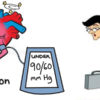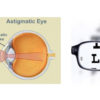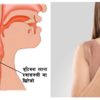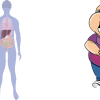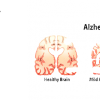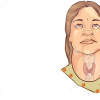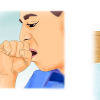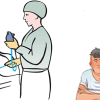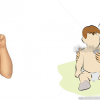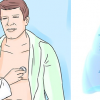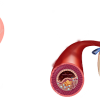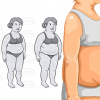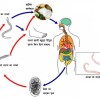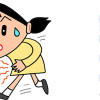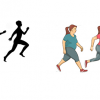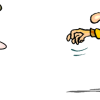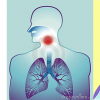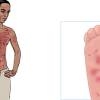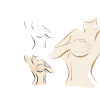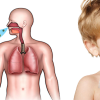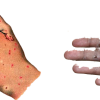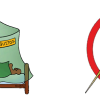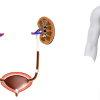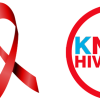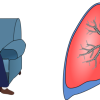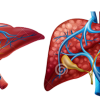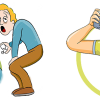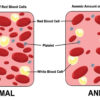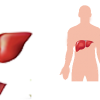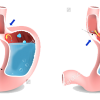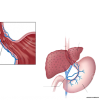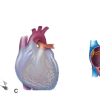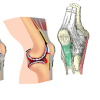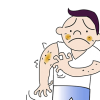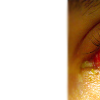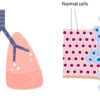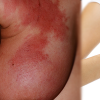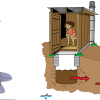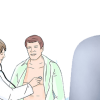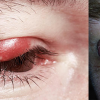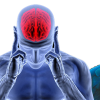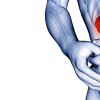Tag:
-
Syphilis
Introduction Syphilis is one of the better-known sexually transmitted diseases (STDs). Like other STDs syphilis can be spread by any type of sexual contact. Syphilis can also be spread from an infected mother to the fetus during pregnancy or to the baby at the time of birth. It is caused by the bact
-
Hypotension
Introduction : The pressure exerted by the blood on the wall of the blood vessels while circulation is known as blood pressure. There are two readings of blood pressure- Systolic and diastolic. Systolic is the pressure exerted while heart contracts and pushes the blood to the vessels and diastolic i
-
Shingles / Herpes Zoster
Introduction : Shingles or Herpes Zoster is a viral infection, generally seen along the neck, chest, stomach, and back on the surface of the skin. It is caused by the same virus of chickenpox, named varicella-zoster. So, it is developed to those people who have suffered from chickenpox previously. T
-
Hypertension
High blood pressure is a very common condition when left untreated for a long period leads to many serious diseases like heart disease, kidney disease, peripheral vascular disease and stroke. Hence high blood pressure is also called a "silent killer". Blood pressure is the force of blood pushing against th
-
Thyroid Disorder
The thyroid is a gland in the middle of the lower neck around Adam’s Apple. It is the gland that makes thyroid hormones, thyroxine (T4) and triiodothyronine (T4). Thyroid hormones determine your body’s metabolism, regulates heart rate and controls body temperature. The production of these hormones (T3, T4
-
Rheumatic Fever
Rheumatic fever is a systemic illness which can occur after a throat infection with a bacteria called Streptococcus pyogenes. It’s serious illness that can cause permanent damage to the heart. Rheumatic fever is common in underdeveloped countries like Nepal. It is most common in children (5 to 15 years old) but can o
-
Schizophrenia
Introduction :
Schizophrenia is a serious mental disorder. Schizophrenic people often hear voices which aren't there and may see the scene which isn't real. They may feel other people are trying to hurt them. Actually, the word schizophrenia is comprised of two Greek w -
Blurry Vision
Blurry vision is the loss of sharpness of vision that results in inability to see fine details. Blurry vision occurs when the function of the structure of eyes - lens, cornea, vitreous fluid, retina, optic ne
-
Dizziness
Dizziness is a term used to describe a range of sensations like feeling of spinning, swaying, tilting, floating or woozy. You may also feel that you might faint (lightheadedness) or sometimes you may have difficulty walking straight. When dizziness is associated with a feeling of yo
-
Difficulty swallowing (Dysphagia)
Dysphagia is the inability or difficulty in swallowing food or liquid. Normally, muscles in the throat (pharynx) and esophagus (food pipe) contract rhythmically to move food and liquids from mouth to stomach. Dysphagia occurs when there is a narrowing or lack of coordination of movem
-
Appendicitis
Appendicitis is the inflammation of the appendix. Appendix is a small, finger-shaped tubular structure attached to the large intestine located at the right side of lower abdomen. There is no known function of appendix in human body. When infected with bacteria or due to the blockage, the appendix gradually swells and g
-
Alzheimer’s Disease
Alzheimer’s disease is a disorder of brain function where you experience a gradual and progressive decline in your memory along with other intellectual function of the brain. The rate with which the disease progresses varies between people to people. They also develop problems related to thinking, social behavior and
-
Abdominal Pain
Pain felt between the ribcage and pelvis is called abdominal pain. It is a very common symptoms experienced by just about everyone at some point of time in their life. Abdominal pain can be generalised over entire abdomen or more commonly localised to one area. Based on the anatomic structure that gives rise to the pai
-
Lung Cancer
Lung cancer (Bronchogenic carcinoma) is the most common type of cancer worldwide and a leading cause of cancer death for both men and women. Lung cancer occurs when the normal cells of lungs abnormally change their characteristics and grow uncontrollably. Lung cancers may be
-
Shortness of breath (Dyspnea)
Shortness of breath or dyspnea is an abnormal awareness of own breathing. It is described differently by different people. Some describe it as not getting enough air or feeling suffocated while others describe it as a sensation of chest tightness or inability to breath out completely. Dy
-
Neck Swelling
Any abnormal enlargement of structures between chin and clavicle bones can cause a neck swelling. Neck swelling usually occurs as a result of disease of lymph nodes in the neck or thyroid gland. Sometimes salivary glands and diseases of muscle and skin around neck may produce a swelling. A neck swelling from enlarg
-
Chest Pain or Tightness
Chest pain is the pain that may be felt anywhere from the level of shoulder to the bottom of ribs. Chest pain or tightness is sometimes a serious symptom, resulting from heart attack. But having chest pain does not necessarily mean you are having a heart attack. Most people who go to the emergency room with chest pain
-
Fever
Definition A fever or pyrexia is a rise in body temperature above normal and often indicates an illness. Average normal body temperature is 98.6oF but it can range between 97 and 99.5
-
Palpitation
Palpitation is a condition where you become abnormally aware of your own heartbeat. You may feel a sensation of skipped heartbeat, rapid and irregular heartbeat, a forceful thumping or fluttering sensation in your chest. Palpitation,
-
Blood Cancer (Leukemia)
Introduction Blood cancer encompasses cancers that originate in the bone marrow (organ that produces blood cells). Most of the blood cancers involve white blood cells (cells that fight infection) and are called leukemia. Cancers can also develop in the red blood cells (cells that carry oxygen) and p
-
Cough
Cough is our body’s protective response to the presence of irritants in the airway. It is a reflex action caused by the stimulation of the nerve endings in the respiratory tract by stimuli such as allergen, microbes, foreign body or excessive mucous. After the stimuli reaches the bra
-
Black stools
Black stools can be due to bleeding in gastrointestinal (GI) tract or ingestion of certain medications (iron, bismuth) or certain food (blueberries). Black, tarry, sticky and smelly stool is caused by bleeding in the GI tract, and is known as melena. Malena is a serious medical
-
Pneumonia
Pneumonia is an infection of the lungs caused by a variety of germs. These germs reach the air sacs (lowest part of airways) after inhalation, overcoming body's normal defense mechanism like nasal hairs, mucus and cough which are weakened by smoking or dust inhalation. Once in the lungs,
-
Tuberculosis
Tuberculosis (TB) is a communicable disease caused by Mycobacterium tuberculosis. It can affect any organ in the body but lungs (Pulmonary TB) are the most common site of infection. Other common sites of infection are bones, lymph nodes, kidneys, uterus, brain (meninges), skin, etc. Tuberculosis i
-
Acute Kidney Failure
Kidney failure means the kidneys become unable to filter the blood and remove waste and excess salt and water from body. Kidney failure can occur acutely over hours and days or develop gradually over a period. When kidney stops working abruptly, it is called acute kidney failure (injury) . When kidney function
-
Weight Gain – Obesity
A person is said to be obese if s/he weighs much more for his or her height. An obese person is at risk of developing many health problems as s/he has excess body fat, which is undesirable. A special measure based on weight and height, called “body mass index,” or BMI is used to find out if a person is underweight,
-
Constipation
Constipation is a common problem related to your bowel movement, when the stool is too hard, difficult to get out and occurs in small amount, less than three times a week. You might have abdominal cramps, may feel bloated or even sick if it is severe and prolonged. Why does
-
Ascariasis
Ascariasis is infestation of humans intestine by roundworm (Ascaris lumbricoides). The roundworm may reside in the guts for 6 to 24 months. The eggs are passed into the stool and under warm, shady, moist conditions they can survive for up to 10 years. The infection is transmitted by in
-
Excess Urination
Excess urination can be frequent urination (with normal total urine output) or urinating abnormally large volume of urine (usually more than 3 liter/24 hours in adults) called polyuria. It is a common problem in men and women of all ages but more common in middle age or older indiv
-
Weight Loss
Weight loss that is meaningful clinically (in relation to your disease) is the loss of more than 5% of usual body weight over a six-month period. This arbitrary cut-off needs to be considered carefully as this does not tell about whether the given weight loss is due to loss of body fat (
-
Fatigue / Tiredness
Tiredness means you feel exhausted both during activity as well as rest,, even while sleeping as well. It is not a disease but could be a symptom of various physical and psychological ailments. It can alternatively be called as fatigue; exhaustion; lethargy or weariness. We all
-
Sore Throat
Sore throat (Pharyngitis & Tonsillitis) refers to pain, irritation or itchiness of the throat resulting from inflammation of the lining of throat and tonsils. It is common infection in children, but can affect people of any age. Symptoms include dryness of throat, swollen glands in
-
Pins and Needles
Tingling and numbness are the loss of normal sensation in the various parts of body. Tingling is the prickling sensation also known as pins and needles and it is usually felt in hands and feet. Numbness is when one cannot feel any sensation in part of his/her body. <
-
Headache
Headache Headache is pain felt in any region of the head upto upper part of the neck . Brain itself is pain insensitive, but surrounding structures like coverings of brain, arteries and muscles are pain sensitive. Stimulation of these pain sensitive areas from inflammation and
-
Vitamin Deficiency
Vitamins are a group of substances that are needed, in very small amounts, for your body to grow and develop normally. There are two broad categories of Vitamins based upon how they are absorbed:
- Fat-soluble vitamins
-
Skin Rash
Skin rash is any change in color or texture of the skin. This happens due to wide variety of conditions, some are limited to skin while others affect mucous membrane or internal organs. So skin rash may be mild illness or a very serious condition. Causes of Ras
-
Viral Exanthems
Exanthem means skin rash or eruptions. Viral exanthems are skin rashes that develops in response to an infection from a virus. Viral exanthems are common in children. They usually appear abruptly and are preceded by fever, cough and malaise. There is a relationship between the
-
Nausea and Vomiting
Nauseas and vomiting are usually manifestation of some underlying disease that are usually non life threatening. Occasionally, it might be an indicator of underlying serious conditions like brain disease, intestinal obstruction and heart disease. Nausea is the feeling of uneasiness in th
-
Protein Energy Malnutrition
Protein energy malnutrition (PEM) is a potentially fatal disorder of undernutrition in children. It is a leading cause of death in developing countries. It refers to a form of malnutrition where there is inadequate
Vomiting of blood (Hematemesis)
Hematemesis refers to the presence of blood in your vomit or vomiting of pure blood that originates in upper part of your gastrointestinal tract. It needs to be differentiated from spitting blood mixed saliva which arises from teeth, mouth and throat. It also need to be differentiated
Red Eye
When the white part of eyes appears red, it is called a red eye. It is caused by dilatation of local blood vessels due to inflammation usually from either infection or irritation. Red eye can be a manifestation of local eye pathology or a sign of systemic disease. Red e
Back Pain
Definition Pain felt between the nape of the neck to the buttocks, usually in the midline, can be referred as back pain. Disease and conditions affecting the bones and muscles that constitutes the spine cause back pain. It can occur anywhere along the spine but pain in lower
Menstrual Irregularities
Menstrual abnormalities include irregular menstrual cycle, heavy bleeding and painful menstruation. Irregular menses denotes variation in the length of a menstrual cycle. A menstrual cycle is the period between the first day of bleeding of one cycle to the onset of next period of bleeding. A normal menstrual
Itching
Itching, also known as pruritus, is an uncomfortable and irritating sensation of the skin that induces an urge to scratch. An itchy skin most of the time is caused by a skin condition. Not infrequently, an itchy skin is a manifestation of a systemic disease. An itchy skin might b
Change in Urine Color
The colour of urine normally ranges from pale yellow to brownish yellow depending upon the amount of a pigment known as urochrome in the urine or the concentration of urine itself. The darker the colour of urine, the more concentrated it is. The urine is normally more concentrated afte
Coughing up Blood
Coughing up blood can be alarming, even in small amounts. But not all hemoptysis is serious or life-threatening. The blood may be mixed with the sputum or it could be frank blood which could be bright red, dark brown or pink and frothy. When you cough up blood, most of the time it is c
Breast Lump
Breast lump is the growth of extra tissue within the breasts. The extra tissue may be felt like a distinct mass or it can be felt as a firm, thick and hard area or as a red and swollen area. There may other a
Upper Respiratory Infection (URI)
Upper Respiratory Infection (URI), also known as common cold is an inflammation of the upper respiratory tract (nose, throat and sinuses) caused by viruses. It is the most frequent illness in both children and adults. Adults may get up to 2 to 3 episodes in a year, whereas children may
Systemic Lupus Erythematosus (Lupus)
Systemic lupus erythematosus (SLE) is a disease of immune system that can affect many organs in the body. Normally, the immune system produces proteins directed against infectious agents and protects us from infection. In SLE, however, your body produces antibodies that attack body’s o
Sexually Transmitted Diseases
Sexually transmitted infections (STIs) are the infections caused by a sexual contact with an infected person. Some of these infections can also spread from mother to infant or unborn babies. The microorganisms enter the body via the skin and mucosal linings of the genitals (ure
Scabies
Scabies is a highly contagious parasitic skin infection caused by the itch mite Sarcoptes scabiei. It mainly spreads by prolonged direct skin to skin contact with infested person. Sometimes sharing articles like towels, bed or clothing may spread it. Incubation period (time
Ringworm
Ringworm (Tinea) is a contagious infection of the superficial layer of the skin caused by a fungus. Common fungus that cause ringworm are Trichophyton and Microsporum species. The name ringworm comes from the appearance of the lesion which is a red, advancing circular lesion with clearer skin in the center. T
Rabies
Rabies is a viral disease of mammals affecting the brain and the nervous system. It is transmitted to humans by the bite of a rabid animal. From the site of the bite, the virus travels via nerves to the brain. Then it spreads to other organs including, salivary gland and is shed in saliv
Malaria
Malaria is a febrile, mosquito-borne disease caused by parasitic protozoa, Plasmodium. Four different species of Plasmodium cause malaria. The parasite is transmitted by bite of female Anopheles mosquito. It occurs mostly in high temperature areas - tropical regions and the Terai belt of Nepal. Infected female Anoph
Kidney (Urinary) Stone
Urinary stones are formed anywhere in the kidneys, the tubes draining urine (ureters) or the urinary bladder. These are formed from the accumulation of substances like calcium, oxalate, cystine, or uric acid which are present in urine. If thes
HIV/AIDS
Introduction HIV (Human Immunodeficiency Virus) is the virus that causes AIDS (Acquired Immunodeficiency Syndrome). Infection by HIV weakens your immune system. When the immune system becomes too weak to fight, organisms that would otherwise not cause an infection in a normal person, that person is
Heart Failure
Heart failure means your heart is not able to pump out sufficient amount of blood into the rest of the body. It does not mean that your heart has stopped to beat which is called “cardiac arrest” (see Heart Attack for more informat
Heart Attack
Heart attack is a leading cause of death in adults. The medical term for heart attack is myocardial infarction. Heart attack occurs when the blood flow to the heart is severely reduced or completely blocked. The heart muscle needs regular supply of blood and oxygen to survive.
Gum Disease
Gum disease or periodontal disease is a common condition where the tissues supporting the teeth like gingiva, cementum, periodontal ligament and the alveolar bones are affected. Gum disease ranges from simple gum inflammation to severe disease that results in major damage to the soft tissue and bone that support the
Diarrhea
Diarrhea is defined as increased frequency of defection (more than 3 per day) with excessive or abnormally loose consistency. Stool weights more than 200g/day are sometimes used to define diarrhoea but in the absence of abnormal consistency, weight alone is not an ideal indicator as bowel weight is influenced by high f
Diabetes Mellitus
Diabetes Mellitus (commonly called diabetes) is a chronic disease where your blood sugar levels are persistently high. There is an important hormone called insulin in our body that keeps the blood glucose level within normal range. Insulin is produced by pancreas which is a gland located behind the stomach between the
Chronic Obstructive Pulmonary Disease (COPD)
COPD is a chronic condition of the lungs that causes difficulty in breathing. It is caused by long standing exposure to irritant gas or particles most commonly by cigarette smoking. In developing countries indoor smoke exposure from firewood burning also is an important risk factor.
Cirrhosis of Liver
Liver cirrhosis is a chronic slowly progressive condition where normal liver tissue is replaced by scar tissue. The scar tissue is the final result of injuries to the liver by various substances. The destruction of normal liver tissue leads to reduced synthesis of proteins needed for the
Asthma
Asthma is a chronic respiratory disease that affects your airways (windpipe). The windpipe is inflamed, narrowed and swollen that causes difficulty in breathing now and then. A person with asthma has no difficulty in breathing most of the time except during an asthma attack. As
Anemia
Anemia Anemia is a condition where your hemoglobin level is low. Hemoglobin is the substance found in the red blood cell that carries oxygen in the blood. When you are anemic the oxygen carrying capacity of you blood in reduced and it may not be enough to meet the dem
Hepatitis
Hepatitis is an inflammation of the liver. Liver is one of vital organs and largest internal solid organ. Liver has large blood supply and functions as a chemical factory removing many unwanted substances from the body. This exposes liver to many insults including infections, drugs or
Gasteroesophageal Reflux Disease
Gasteroesophageal reflux disease (GERD) is also known as acid reflux. GERD occurs is when stomach contents leak backwards (called “reflux”) into esophagus and cause symptoms or complications. Reflux is a normal process in infant, child or adult, but when it causes troublesome s
Esophageal Varices
Esophageal varices are abnormally swollen veins in the lining of the lower esophagus. Most of the time, esophageal varices develop due to obstruction in the portal venous circulation (blood flow through the liver) but mainly it occurs when a healt
Diphtheria
Diphtheria is an infectious disease caused by bacteria Corynebacterium diphtheriae. The infection affects the respiratory passage leading to sore throat and breathing difficulties. The disease produces a
Depression
Depression is a condition where people persistently feel down or sad. Depression impacts on how people feel, think, and behave; as a result it affects your normal day-to-day activities. Hence if severe enough, it can be very distressing. Depression can be major or minor. Usually you are diagnosed with depression if you
Autism Spectrum Disorder (ASD)
Autism Spectrum Disorder (ASD) is a disorder of brain development that impairs child’s ability to communicate and interact with others. Children with this disorder have poor social communication, social interaction skills and have limited set of interest and activities. These chi
Atrial Fibrillation (AF)
Atrial Fibrillation (AF) is a disorder of heart rhythm that manifests as an irregular heartbeat. Usually, it is associated with rapid heart rate ranging from 100 to 170 beats per minute. But you can have atrial fibrillation with normal heart rate specially if you are treated with med
Arthritis
Arthritis means inflammation of joints. It is a generic term that encompasses hundreds of conditions where joint inflammation causes symptoms of pain, swelling and stiffness of joints. Two most common causes of arthritis are Osteoarthritis (OA) and Rheumatoid Arthritis (RA). Arthritis ca
Allergy
Allergy is a conditions where your body abnormally reacts to foreign substances that normally should not produce any reaction. These substances are called allergens. Your immune system, which is responsible for protection of the body against external agents, recognizes these allergens as “invaders” and produce prot
Conjunctivitis
Conjunctivitis is an infection or inflammation of conjunctiva, a thin layer that covers the white part of eye and inner parts of the eyelids. Normally, transparent conjunctiva becomes red or pink when inflamed. It is caused by infectious (spreads easily from person to person and from c
Cataract
Cataract occurs when the lens of an eye becomes cloudy and affects vision. Almost half of the blindness worldwide is estimated to be caused by cataract. It is the major cause of blindness in developing countries. It is a gradual change in the structure of the lens in an eye. Hence, it usually manifests in older age
Cancer
Cancer is a disease of abnormal cell proliferation. In a healthy organs, cells divide and grow in a regulated and controlled fashion. When these cell start to divide and grow unpredictably and uncontrollably, it develops into a lump know as tumor. These groups of abnormal cell can infiltrate causing destruction of surr
Breast Cancer
Breast cancer occurs when normal cells of breast change their characteristics and grow uncontrollably. Breast Cancer is the second most common cause of cancer death after lung cancer. Nearly one million women are diagnosed with breast cancer each year. It is usually detected as a breast
Amoebiasis/Giardiasis
Amoebiasis is an infection of gastrointestinal tract caused by an intestinal parasite called Entamoeba histolytica. It causes dysentery, liver abscess and rarely affects lungs, heart and brain. It occurs everywhere in the world but especially in the areas where there is poor sanitation and poor socioeconomic status. Th
Acid Reflux Disease
When we eat food, it travels through the mouth to the food pipe (esophagus) and then to the stomach. Once in the stomach, food cannot come back up into the esophagus under normal conditions because of the presence of the lower esophageal sphincter (LES). LES is a group of fiber muscle rings at the lower end of the food
Tetanus
Tetanus is a vaccine preventable disease of the nervous system caused by a bacteria Clostridium tetani. This organism is widely distributed in soil contaminated with animal and human feces. The spores formed by the bacteria can survive for years and is resistant to various disinfectants and even boi
Stye and Chalazion
Stye and Chalazion are lumps or swelling of eyelids. Stye is a acute and painful condition caused by an infection whereas chalazion is a chronic and painless condition. Stye (also known as external hordeolum) results from infection of the root of an eyelash by a bacteria called Staphyl
Stroke
Stroke is a medical emergency. It occurs when the blood supply to the brain is severely compromised or suddenly cut off. As a result, the brain cells begin to die due to the lack of oxygen and nutrients. A permanent damage can result if blood flow is not restored promptly. If the blood
Sinusitis
Sinusitis refers to the inflammation and swelling of the sinuses. Sinuses are cavities found in the bones of our face. There are four sinuses and are located around the nasal passages. These cavities communicate with the nasal passage via four narrow openings. These openings drain the
Tingling or Numbness
Meaning: Tingling and numbness are the loss of normal sensation in the various parts of body. Tingling is the prickling sensation also known as pins and needles and it is usually felt in hands and feet. Numbness is when one cannot feel any sensation in part of his/her body. Why does it M
Peptic Ulcer Disease
Peptic Ulcer Diseases (PUD) are conditions where the lining of the stomach and the duodenum (first part of the small intestine) are damaged leading to the formation of open sores. The stomach and duodenum are in constant contact with gastric juice but the presence of a protective layer o
Jaundice
Jaundice is a condition in which your skin and eyes turn yellow due to high levels of bilirubin in the blood. Bilirubin is a yellow pigment that is normally produced in our body when old red blood cells die. These pigments are then metabolised by the liver and excreted into the intesti
Hyperuricemia
Blood uric acid level above normal range is called hyperuricemia. Uric acid is formed in the liver when body breaks down purines and is excreted by the kidneys. Purines come from diet and our body. Purine rich diets are red meat, organ meat (liver, kidney), seafood (sardines, anchovies), beer, dried beans and peas, spi
Hookworm Infestation
Hookworm infestation is a parasitic disease of humans caused by one of the two organisms- Ancylostoma duodenale and Necator americanus. It is the second most common helminthic infection in developing world. Hookworms are found in soil contaminated by human feces. The transmission of infection occurs when the following
High Cholesterol
Cholesterol is a type of fat that circulates in the blood. Your body makes some amount of cholesterol and the rest comes from the food you eat, mainly the animal products (plants do not contain cholesterol). Some amount of cholesterol is needed to build healthy cells but having high levels of cholesterol can increase t



